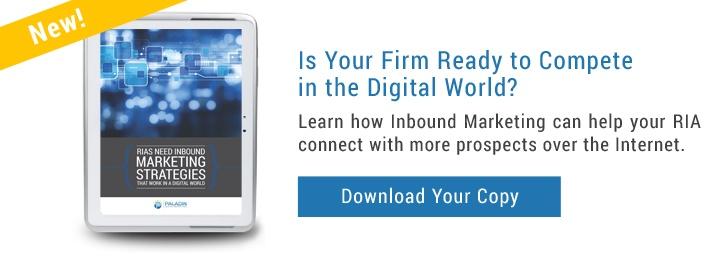

Good Financial Advisor Branding vs. "Anti-Branding"
Branding is probably the most misunderstood aspect of financial advisor marketing. Perhaps due to heavy regulation that these firms are subject to, most financial advisors have yet to conceptualize what a brand really is, or how it can make a difference in their business. This blog will study two dominant brands and outline the aspects that make them strong. We will also discuss the elements of poor financial advisor branding (what I call “anti-branding”) that are commonly seen throughout the industry.
Branding is the Gatekeeper
Just as a receptionist is the gatekeeper who screens the telemarketer’s calls, the brand is the gatekeeper keeping your online and print content out of the hands of your prospects. Win over the receptionist, and you earn the right to a few minutes of the boss’s time. Master your brand, and you’ll get the decision maker’s attention on the Internet, at conferences, or through referral relationships with centers of influence. Do it badly, as most firms do, and you’ll end up with a harmonica instead of a microphone, your calls will be screened, your email will go to the spam folder, meetings get canceled, and on and on.
Branding is hard to conceptualize because it’s intangible. Certain facets of branding such as a business card or a logo are concrete, but most of a brand’s strength is driven by elements that can not be seen but rather felt. It’s an “x factor”, a force, an energy that is summoned by impact of the presentation.
Here are the most concrete aspects of branding: your business income statement, your AUM, your AUA, the number of deals won this year. You can see the brand right there; the strong brands sell and the weak brands falter. This is how the intangible translates into the tangible.
Have you ever been in a deal where you thought you had it stitched, only to find out that they chose their brother-in-law who works at Merrill Lynch or who sells insurance at New York Life, because they didn’t want to pay your fee? Or maybe they gave you no reason at all and just disappeared. It would be disingenuous to say that this doesn’t happen to the big brands but the truth of the matter is that many times when deals are lost, branding is to blame.
Here are two examples of solid financial advisor brands.
Ellevest
Founded by Bank of America executive Sallie Krawchek, Ellevest is an up and coming small digital advisor with a big ol’ brand. The first thing I like about the Ellevest website is that when you visit, you are hit with a unique message right away, “Invest like a woman, because money is power.” Do you see how the tagline creates movement? First it identifies what the company is about (helping women invest) and then it inspires you with the reason why you should do it their way. The most powerful evangelists in history have used “why” as the motivator. In two simple sentences, this brand establishes “what” and “why” and makes a great first impression.
You’ll also notice that Ellevest has a great repertoire of colors. The tones are soft yet vibrant at the same time, warm purples and blues splashed on top of just the right blend of lights and darks in the background. The aesthetic is beautiful, and the language on the website flows naturally. This sets them apart from the harsh, rigid, jargon-spouting websites that most financial advisors have.
The other great thing about this brand is the way that it calls attention to what makes it different, right away on the front page. “Ellevest is the only digital advisor that takes women’s unique, lifetime salary curve into account.” This is a great hook for women because it makes sense, as many women have had to put their work on hold to take care of family. I remember how my income fluctuated the two times right after I had my kids, whereas for my husband, no such story. His salary skyrocketed – he was able to get a new, higher paying job three months after we had our first baby, in fact! It’s something I knew subconsciously but never really stopped to think about. By calling attention to something problematic that the audience may overlook, and linking it back to how their service uniquely helps people overcome it, Ellevest establishes trust with those it is trying to reach.
Ellevest uses micro-influencers such as Serena Williams in their press. That’s a great move for the brand. The people who like Serena, a female athletic powerhouse, are likely to favor Sallie, a financial superstar, for the same reason. Influencer marketing, or getting exposure to a large following by way of association through social or traditional forms of media, strengthens the brand when done intelligently.
Because finance is technical, many times the branding centers around the investment philosophy whereas in reality a brand is the people. Ellevest’s “about the founder” section captures the spirit of the mission and gives a purpose that is relatable. Many companies overlook the CEO’s role in conveying the brand. The founder is the person who brought the concept to life. What stands out about them, the dominant aspects of their personality, is what sets the company apart.
Those are the reasons why Ellevest is an elegant and well defined brand.
Chevy Chase Trust
Chevy Chase Trust is an established firm with a modern twist – and it works. By assets it ranks as one of the nation’s largest, but you don’t get an icy feeling at all. They manage to deliver a highly personalized experience right away.
What I love about the website is that when you visit, you are first presented with a video – a great tool for building personal connection with the audience – and secondly a press piece about “The $26 Billion woman.” Including a woman as a person in power defies the typical male dominated presentation that you see on most financial advisor websites. What a captivating landing page!
One of the things that makes this brand great is the absence of stock photos on their website. This is very important, because the culture and the people are the main components of the brand. Not only does Chevy Chase include crisp and professional pictures of their employees, they also feature videos of them speaking in plain, non-technical language that comes across as so warm, inviting, and natural.
The video starts with a simple yet powerful message that sets the firm apart, “In practice, Chevy Chase Trust is an idea factory. We have no shortage of ideas, and we like nothing better than sharing them with clients.” What investment firm talks this way? Do you hear any jargon? Do you hear any buzzwords? No. This makes it flow. Later on in the video you hear about “culture”, “the lost art of conversation”, “thoughtful investment strategy”, “inspired ideas”, “real world opportunities” and that the portfolio managers are “independent free” to pursue their ideas. They are conveying the same point as other brands without using the same tired industry slang that is used so frequently that people stop listening.
The logo is presented dynamically instead of statically, composing itself while each person is talking. The whole presentation in this video clip is one that moves you. You get a sense of the energy of the culture and a moving vibe comes through the screen. Chevy Chase Trust is a captivating brand.
Financial Advisor “Anti-Branding”
Now that we’ve discussed two dominant brands, here’s the flip side. Without pointing to any specific companies, here are some themes that I see in financial advisor marketing that are what I call “anti-branding.” It’s not that these are incorrect, it’s just that they are so tired and overused that they have become a cliché and almost lost their meaning. If you’re using these terms heavily in your practice, you aren’t achieving full branding potential.
- Comprehensive wealth management solutions – This sounds good, but when you really think about it, who doesn’t pride themselves on providing a total solution? Even the brokers who trade stocks without an IPS or an overall guiding philosophy will find some way to tell you that their solution is going to be everything you need. Why diversify? The assets are all correlated anyways, according to them. This term is too vague to really appeal to the audience.
- Fee-based – Yes, we get it that you want to make the point that you’re not going to churn and burn the accounts. But when every single RIA firm makes this point, it loses the ability to set you apart. It should be mentioned but not emphasized but for most financial advisors this is held out as the whole entire branding play.
- Proprietary philosophy – I would hate to break it to you, but most financial advisors aren’t doing anything all that revolutionary with their investment philosophy. Most financial advisor shops offer asset allocation based on the same theories as all the rest, pick stocks based on the same research as all the rest, and allocate to the same ETFs or mutual funds as everyone else. This achieves beta, not alpha. The ones that do something radically different are featured in Barron’s articles because they outperform the pack. Not a differentiator most of the time.
- Customized investment strategies (portfolios) – I’ve made this point in other blogs of mine. Most people don’t care if the portfolio is specific to them or if it comes from a boiler plate as long as it works. There were many customized portfolios that failed in the last crisis. And to my last point, how customized are these portfolios? Take any two customized portfolios and they’re probably more similar than different.
- Client’s unique goals (needs) – The word “goals” inevitably appears on every landing page of every financial advisor’s website. It’s as ubiquitous as the air we breathe. Air is a free commodity that nobody pays for. Financial advisors who harp on the idea of meeting the client’s goals or needs and fail to offer anything unique about how they do it are making their brand vanish into thin air. It’s not that talking about goals is wrong. Just as Ellevest did, relate the goals and needs back to a specific problem that a person may have. And give it a “hook.” Why do we understand your goals better than the next person? Because we are women who know that income interruptions you may be failing to take into account will impact your goals.
- Transparent, independent advice – See “fee based” reference above.
- Trusted advisor – I know you’re supposed to go for the assumptive close, but let’s be real here. Trust in the financial services industry isn’t the best cornerstone for brand equity. Given all the scams that have happened, there is an element of distrust inherent to this industry. It’s almost as if this word brings up all sorts of bad connotations. I’m always skeptical whenever someone says, “Come on, you can trust me! I’m an honest person!”
Financial Advisor Branding Round Up
Creating a brand that sells is truly hard work. It takes time, dedication, and a great deal of self-awareness. Many financial advisors benefit from working with a third party who can help them avoid “anti-branding.” In such a competitive, highly regulated world where technology is only enabling more contenders to enter the fray, a strong brand isn’t an option anymore.
To learn more about Sara Grillo, CFA, visit www.saragrillo.com.

Sara Grillo, CFA
Search Here
Categories
- AI (18)
- blogging (2)
- branding (1)
- content (12)
- custodians (1)
- Digital (345)
- email marketing (3)
- fcmo (2)
- fees (1)
- financial advisor marketing (62)
- Google (3)
- Ideas & Tips (78)
- Investor Experience (7)
- lead generation (7)
- linkedin (1)
- Marketing (371)
- newsletters (1)
- Online Transparency (2)
- search engine optimization (3)
- seo (9)
- Social Media (2)
- video (2)
- Websites (108)
- YouTube channel (2)
Recent Posts
-

-

How Financial Advisor Blogging Generates Thought Leadership and Leads
November 24, 2025 -

Top 5 Ways Digital Marketing Benefits Financial Advisors Seeking Leads
November 20, 2025 -

Trust Is The Biggest Online Marketing Challenge For Financial Advisors
November 17, 2025 -

Compliant Financial Advisor Bios Using AI Website Builders
October 22, 2025

